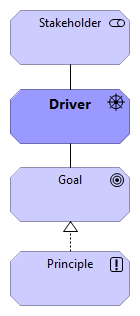Drivers – Goals - Principles
This section contains the driver, goal and principal motivation elements.
The views are organised by drivers, and the corresponding stakeholders, goals and principles are presented linked to the driver.

Drivers


In the ArchiMate® specification, a Driver represents an external or internal condition that motivates an organisation to define its goals and implement the changes necessary to achieve them.
Drivers that are associated with a stakeholder are often called “concerns” of that stakeholder. Stakeholder concerns are defined in the TOGAF® framework as “an interest in a system relevant to one or more of its stakeholders”. Concerns may pertain to any aspect of the system’s functioning, development, or operation, including performance, reliability, security, distribution, and evolvability and may determine the system's acceptability. The drivers are listed by stakeholders, mostly because the generic approach to drivers is different for each stakeholder:
for archives and solution providers, the drivers are mainly about “how to do digital archiving”;
for data providers and regulatory agencies, it is about “what is the benefit of doing/implementing digital archiving”;
for data consumers, it is about “how easy is it to use and what can I get from archived information/records”.
Please note that drivers for the service providers, data providers, and regulatory agencies are partial because we have included only the ones related to digital archiving (i.e. not those related to the stakeholder’s core business). To provide a better understanding of the drivers, we have grouped them into three categories:
Long-term accessibility,
Trust and compliance,
Sustainability and business support.
Goals


In the ArchiMate® specification, a Goal represents a high-level statement of intent, direction, or desired end state for an organisation and its stakeholders. In principle, a goal can represent anything a stakeholder may desire, such as a state of affairs or a produced value. Examples of goals are: to increase profit, to reduce waiting times at the helpdesk, or to introduce online portfolio management. Goals are typically used to measure the success of an organisation. A goal is always associated with a driver. The goals below are presented by the driver (in some cases, a pair or group of similar drivers). In the ArchiMate® specification, the goals are then “realised” by principles. Here we present the principles along with the goals they realise.
Principles


In the ArchiMate® specification, a Principle represents a statement of intent defining a general property that applies to any system in a certain context in the architecture. A system may refer to any active structural element, behaviour element, or passive structural element of some organisation, such as a business actor, application component, business process, application service, business object, or data object.
The eArchiving principles are described in a separate document: Principles for long-term accessibility of information. Though the Motivation aspect defines Principles as one component, we decided to separate and prioritise the work because of extensive community interest. The first version of eArchiving principles has already been released in early 2020 and reviewed by a limited set of experts. This document is accompanied by a third revision of the principles document, which includes received feedback. You can download the Principles … documents in the Downloads section of this model.
Requirements
The most detailed component of the Motivation aspect is the requirements that define a specific realisation for the principles and goals. This version of the motivation aspect does not contain any requirements yet. Instead, requirements will be added after the definition of the Business Layer.